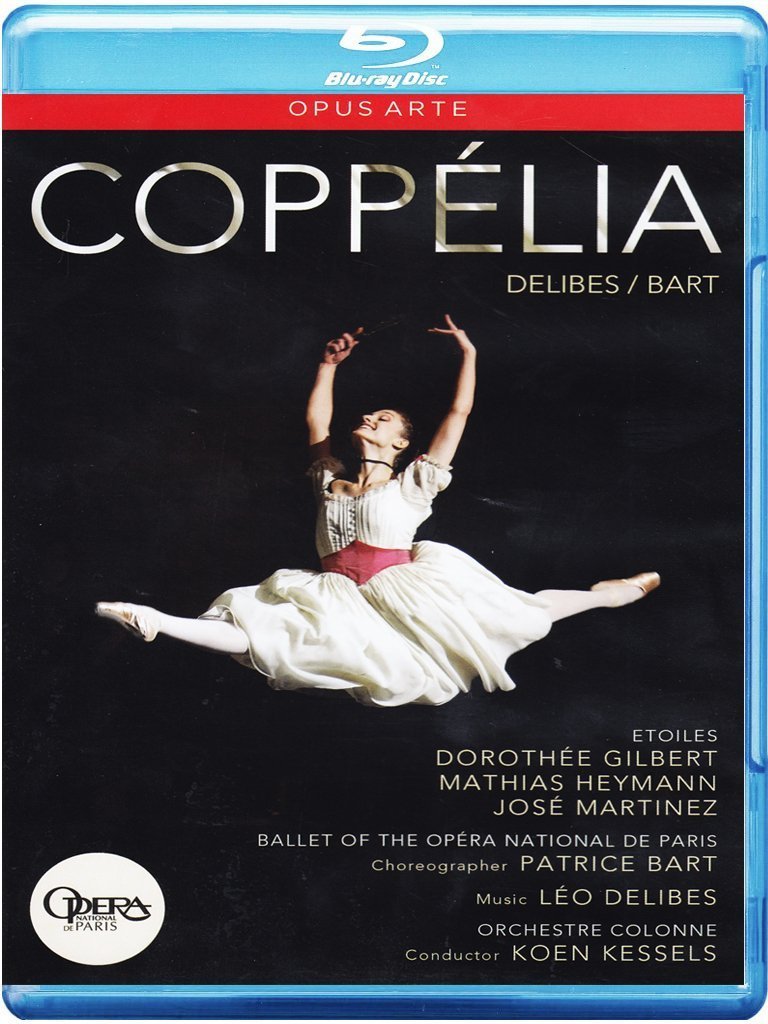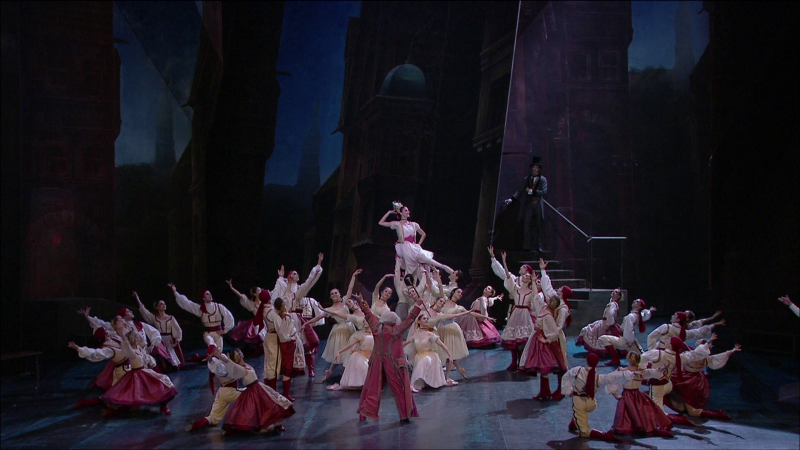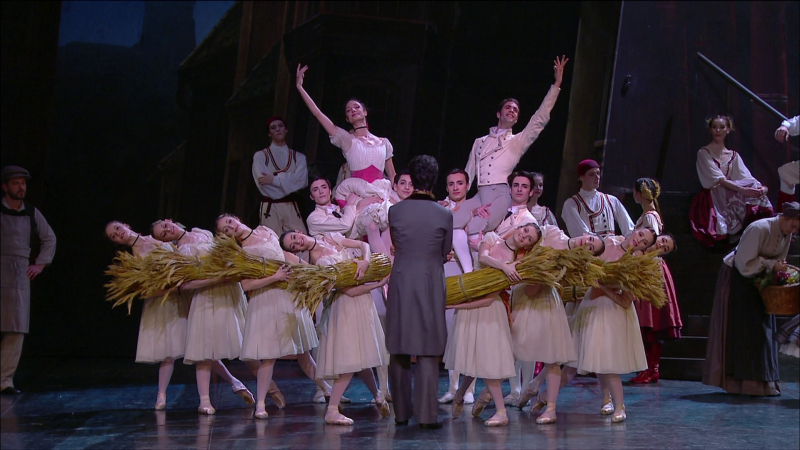

Coppélia ballet. Choreography by Patrice Bart after Arthur Saint-Léon. Music by Delibes. Performed 2011 at the Palais Garnier, Paris. Stars Dorothée Gilbert (Swanilda), Mathias Heymann (Frantz), José Martinez (Coppélius), and Fabrice Bourgeois (Spalanzani) with the Corps de Ballet of the Opéra national de Paris. Koen Kessels conducts the Orchestre Colonne. Staging by Patrice Bart; sets and costumes by Ezio Toffolutti; lighting by Yves Bernard; additional choreography by Claude de Vulpian. Directed for TV by Vincent Bataillon. Released in 2011, disc has 5.1 dts-HD Master Audio sound. Grade: B
According to George Balanchine, Coppélia is ballet's "great comedy." (101 Stories of the Great Ballets, 1975 Anchor paperback, p.75.) There have been many versions, but here's a typical plot: Doctor Coppélius invents a beautiful life-size doll, named Coppélia. Coppélius puts the doll out on the balcony, and Frantz is attracted to her. This angers Franz's real-girl sweetheart, Swanilda (who looks a lot like Coppélia). The couple has a fight just before the Duke's grand ball where newly-weds will get a dowry. Swanilda and her girl friends enter Coppélius's workshop to look for the mysterious girl on the balcony. Swanilda discovers Coppélia is only a doll. Coppélius returns, and Swanilda hides. Coppélius tries to bring Coppélia to life, and Swanilda pretends she is the doll. At first the Doctor is delighted with his success, but he's later dismayed when Swanilda wrecks the workshop and runs away. Franz has learned that the girl he has is the best; he and Swanilda make up and get a gift from the Duke. The Duke gives the Doctor a purse to compensate him for the stuff Swanilda broke, and everybody is happy. There are a lot of joyful dances at the ball in which the ballet master can work to exhaustion every member of the corps.
But subject 2011 Coppélia revival, first choreographed by Patrice Bart at the POB in 1996, is more of a true-crime thriller than a comedy. Here are the prettiest girls in the village. Swanila is in the center. She is played by Dorothée Gilbert, whom we saw in important supporting roles in Dame aux cameléas and Petite Danseuse de Degas. Everybody is celebrating the end of the harvest season:
Frantz, a student (Mathias Heymann) is Swanilda's sweetheart:
Now we meet the mysterious Spalanzani (Fabrice Bourgeois). He's a mad scientist type who lives in a creepy house on the main village plaza. Nobody knows how he makes his living. But here he's offering a special crown and vest for the girl picked as the Harvest Queen:
Swanilda is elected as Queen. Here we see her in front of Spalanzani's house. A mysterious gentleman is standing in front of Spalanzani's door watching the festivities:
The gentleman is Coppélius. He is played by José Martinez whom we know well from his role as Prince Siegfried in the Paris Opera Ballet Swan Lake. Coppélius enters the crowd to dance with Swanilda. This is a big day for Swanilda: first she was crowned the Harvest Queen and now she's being courted by an aristocrat:
All this upsets Frantz terribly, and the peasants don't like what they see either:
Finally, Swanilda is elated when Spalanzani invites her to visit his workshop:
In the workshop, Coppélius smokes opium:
Spalanzani is a master at making life-sized dolls such as soldiers and girls dressed in foreign garb. Now he is at work making a special doll for Coppélius, who was in love with a beautiful ballerina who died. This will be a living doll that will replace the lost love of Coppélius. In the view below we see that the project is near completion. But the doll still needs a some fit and finish:
Swanilda invites her friends to go with her to visit the workshop. No one appears to be home when they enter:
The girls are astonished by what they find. Here Swanilda pretends she is a doll:
Spalanzani chases all the girls away except for Swanilda, who soon finds herself alone with Spalanzani and Coppélius. To finish his living doll, Spalanzani mostly needs Swanilda's soul. But looking at her more closely, he now realizes what a magnificent catch he has. This village virgin has an immaculate pelt: no body piercings, no tattoos, no needle scars, and no stretch marks!
Everybody enjoys a toast of funny-tasting wine:
Spalanzani briefs his client again on the project by showing him the blue-print and what the finished product will look like:
After getting consent from Coppélius, Spalanzani waits for the wine to finish working. Although dizzy, Swanilda begins the recognize the danger she is in:
Too late! Now the Harvest Queen is only moments away from being harvested herself:
But the other girls found Frantz and warned him that Swanilda was alone with Spalanzani. He enters the workshop just in time! He has a fight with Coppélius, who soon sinks into a kind of mad dance. Frantz awakens Swanilda, and the couple escapes. The image below is, I think, a quote from the movie Dr. Caligari:
In an ambiguous ending, Franz and Swanilda marry, but Coppélius still hovers about. Does he plan to try for Swanilda again, or is he looking for another girl to turn into his Coppélia?
There is a good bonus film with this title (the Mystery of Coppélia), in which Patrice Bart, Brigitte Lefèvre, and the principal dancers try to explain this "darker" version of the famous comedy. The cheerful traditional score is augmented with heavier music by Delibes from several of his operas. The set looks like a Lyonel Feiniger cityscape. The costumes are a bit more urban than the rustic villages of the comic Coppélias. But I think the biggest mystery is why they didn't rename it "Swanilda" or "Frantz and Swanilda" or even "Coppélius." All these names would have been more sensible because Coppélia is only a fantasy.
If you try this title after reading this, you will probably be pleased. José Martinez is impressive as the tortured Coppélius, debonair in appearance while collapsing internally. Dorothée Gilbert is an excellent dancer and actress. Fabrice Bourgeois, an invited artist, is great as mad-scientist Spalanzani. Finally, there is a lot of fancy work from the corps, which is often large enough to make the stage seem almost crowded. The video is a bit soft but acceptable. The orchestra Colonne plays well and is well recorded.
Because the Patrice Bart angle on this ballet is so extreme and different from what most fans would expect, I start with the grade of C. But the well-drilled dancers and expert supporting artists of the POB can, through sheer competence, drag almost anything up a notch or two. So I get over the emotional paucity of the plot and wind up with a B for this title.
Here's a nice clip:
OR




















